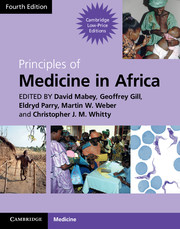Book contents
- Frontmatter
- Contents
- Contributors
- Foreword
- Section 1 Health and disease
- Section 2 Mother and child health
- 5 The pregnant patient
- 6 Neonatal care
- 7 The integrated management of childhood illness (IMCI)
- 8 Severe acute malnutrition in childhood
- 9 Diarrhoea
- 10 Pneumonia and other acute lower respiratory tract infections in children
- 11 Measles
- 12 Pertussis
- Section 3 Infection: general principles
- Section 4 Major common infections
- Section 5 Bacterial infections
- Section 6 Viral Infections
- Section 7 Protozoal infections
- Section 8 Helminth infections
- Section 9 Fungal infections
- Section 10 Non-communicable diseases
- Section 11 Diseases of body systems
- Section 12 Cancer and Palliative Care
- Section 13 Venoms and Poisons
- Index
- References
10 - Pneumonia and other acute lower respiratory tract infections in children
from Section 2 - Mother and child health
Published online by Cambridge University Press: 05 March 2013
- Frontmatter
- Contents
- Contributors
- Foreword
- Section 1 Health and disease
- Section 2 Mother and child health
- 5 The pregnant patient
- 6 Neonatal care
- 7 The integrated management of childhood illness (IMCI)
- 8 Severe acute malnutrition in childhood
- 9 Diarrhoea
- 10 Pneumonia and other acute lower respiratory tract infections in children
- 11 Measles
- 12 Pertussis
- Section 3 Infection: general principles
- Section 4 Major common infections
- Section 5 Bacterial infections
- Section 6 Viral Infections
- Section 7 Protozoal infections
- Section 8 Helminth infections
- Section 9 Fungal infections
- Section 10 Non-communicable diseases
- Section 11 Diseases of body systems
- Section 12 Cancer and Palliative Care
- Section 13 Venoms and Poisons
- Index
- References
Summary
The problem in Africa
Minor viral respiratory infections are common in childhood, while pneumonia is the most important cause of serious illness and death in young children globally. It is estimated that pneumonia causes almost 2 million deaths in children under 5 years of age each year. In African countries where malaria is an important problem, pneumonia causes a similar number of child deaths (Fig. 7.1). Pneumonia is generally a more common cause of death in those countries that have the highest infant mortality rates. Risk factors are malnutrition and exposure to indoor smoke, and lack of access to basic medical care is behind most pneumonia deaths. This remains a problem in many African countries. Untreated, the case-fatality rate is particularly high in the first 6 months of life.
Wheezing disorders are less common in African countries than in developed parts of the world. Acute bronchiolitis, usually due to respiratory syncytial virus (RSV), is an important cause of severe respiratory infections in young infants, yet asthma remains uncommon, except in urban areas. Viral laryngotracheobronchitis (‘croup’) is uncommon in African countries, so an acute presentation with upper airways obstruction should prompt a search for more serious conditions such as abscess, foreign body or diphtheria.
- Type
- Chapter
- Information
- Principles of Medicine in Africa , pp. 123 - 134Publisher: Cambridge University PressPrint publication year: 2013

